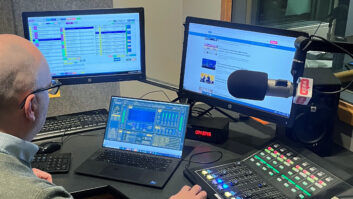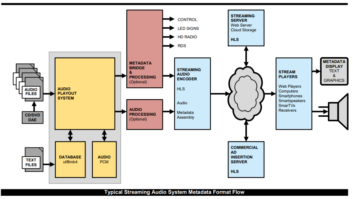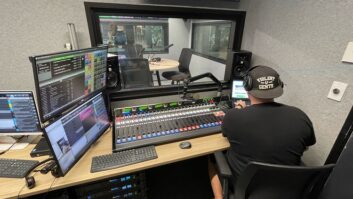Patent Holders Step Up Licensing Efforts By Soliciting Broadcasters for Fees
DENVER Two Colorado businessmen say they hold the rights to the process by which radio broadcasters substitute content from their on-air signals with alternate materials for their Web streams; and they want stations to pay for using the technology.
The business partners, David Minter and Al Baldocchi, believe their ad-insertion patent is becoming more valuable as streaming media usage increases and more groups resume or begin streaming. They are now approaching major broadcast groups in regards to licensing the ad-insertion process.
However, some analysts believe it’s unlikely broadcasters will ever pay to use it.
The patent – “Internet Radio System With Selective Replacement Capability” – covers the real-time removal of content in an Internet radio broadcast and was issued by the U.S. Patent and Trademark Office in 2003 to Minter and Baldocchi.
According to the patent, “The invention is directed to the replacement of the portion of the content in a radio station broadcast that is distributed over the Internet that is local in nature or otherwise unsuitable for the Internet audience with content that is relevant to the broader audience that is capable of receiving the Internet broadcast.”
Streaming is back
Burdensome copyright rules had forced many stations off the Internet in 2002. However, recent research – such as the finding by Arbitron and Edison Media Research that the Internet radio audience has grown to 37 million per month – has convinced some broadcasters to resume streaming content.
“From our perspective there has been more interest in the past several months … in licensing or buying our patent,” Minter said. “We are confident that our ad insertion patent is an asset that is growing in value over time, just as Internet radio is growing.”
Minter is president of Minter and Associates, a consulting practice that specializes in the entertainment industry, based in Denver. Baldocchi is an independent business consultant and investment banker in Boulder.
Broadcasters using the patented process and companies that provide ad-insertion software have been a part of discussions regarding the patent, Minter said.
“We have contacted the top 10 broadcast groups, in terms of stations owned, regarding buying the patent or signing licensing agreements. No one has disputed the fact that we hold the patent. Some are doing due diligence right now to understand the patent and what it covers,” Baldocchi said.
Ad insertion allows broadcasters to replace local commercials with content that would be more suitable for listeners over a larger geographic area, Minter said. “An example would be replacing local material with an ad for Coke or Pepsi for the Internet stream.”
But broadcasters likely will look to software companies or streaming providers as the parties that should pay, said George Bundy, chief executive officer of BRS Media, an Internet consulting firm that specializes in radio streaming.
User pays
Minter declined to speculate on the estimated value of the patent. He said the businessmen have contacted several software companies that sell insertion products, but are concentrating their efforts on striking license agreements with broadcasters.
“We think that strategically this patent fits best in the hands of a broadcaster. They are the ones using the technology. We hope to eventually find either a strategic buyer or a group that has interests in patents and patent enforcement to sell to,” Minter said.
Licensing intellectual property, or enforcing it, is sometimes an expensive process, Minter said. “I don’t believe that is the way for us to go. I think eventually we will sell the patent,” he said.
Ad insertion capabilities came onto the industry’s radar screen 2001 when the American Federation of Television and Radio Artists voiced concern over additional talent fees due its members for the second use of copyrighted material as a result of Web streams, analysts said.
“Even though the AFTRA issue still remains, ad insertion makes it almost a non-issue anymore,” Bundy said.
Clear Channel, Entercom and Infinity Broadcasting are among the broadcast groups making a heavy commitment to streaming, Bundy said.
“A few major groups have plans for major Internet initiatives for 2005,” Bundy said. “We are seeing stations coming back on at a steady rate, especially in the major markets.”
What broadcasters say
That includes nearly equal numbers of news/talk and music stations, Bundy said, now that copyright issues are pretty much settled, including performance fees paid by over-the-air broadcasters to artists because of their Web streams.
“The fear of the unknown has been pretty much settled and (broadcasters) are better able to gauge their streaming costs,” Bundy said.
A Clear Channel spokeswoman confirmed that Minter and Baldocchi have contacted the company about the patent but declined further comment. Infinity Broadcasting and Emmis Communications officials said they could not confirm that the patent holders had contacted them.
Several suppliers offer products that incorporate ad insertion functions. For example, Broadcast Electronics’ SoniXtream Web-based media delivery system has ad replacement and insertion capabilities.
Neil Glassman, BE vice president of strategic planning, said, “There are certainly intellectual property matters to be considered when radio stations stream their programming. BE is vigilant in respecting the intellectual property rights of others in all of our product and service offerings.”












